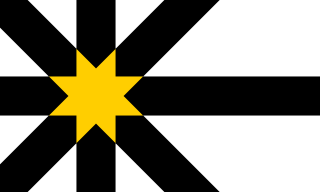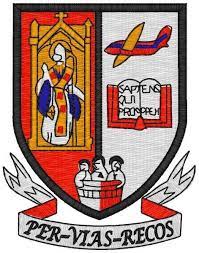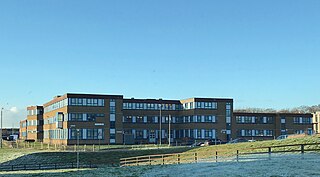
Sutherland is a historic county, registration county and lieutenancy area in the Highlands of Scotland. The name dates from the Viking era when the area was ruled by the Jarl of Orkney; although Sutherland includes some of the northernmost land on the island of Great Britain, it was called Suðrland from the standpoint of Orkney and Caithness.

Tain is a royal burgh and parish in the County of Ross, in the Highlands of Scotland.

A comprehensive school is a secondary school for pupils aged 11–16 or 11–18, that does not select its intake on the basis of academic achievement or aptitude, in contrast to a selective school system where admission is restricted on the basis of selection criteria, usually academic performance. The term is commonly used in relation to England and Wales, where comprehensive schools were introduced as state schools on an experimental basis in the 1940s and became more widespread from 1965.

Bonar Bridge is a village on the north bank of the Kyle of Sutherland to the west and the Dornoch Firth to the east in the Parish of Creich in the Highland council area of Scotland.

Inverness Royal Academy is a comprehensive secondary school in the city of Inverness in the Highland area of Scotland.

Kilmarnock Academy, formerly Kilmarnock Burgh School, is an 11–17 co-educational state-funded secondary school in Kilmarnock, Scotland, currently serving in its third location on Sutherland Drive in the New Farm Loch area of the town. Previous sites for Kilmarnock Academy include College Wynd, erected during the 1680s–1690s, Green Street, erected in 1752, and Elmbank Drive, erected in 1898.

Prestwick Academy is an 11–18 non-denominational secondary school in the town of Prestwick, South Ayrshire in Scotland. The school is the responsibility of South Ayrshire Council, with its current headteacher Elaine Harrigan having overall responsibility for the school's day–to–day running. With a pupil roll of 1,201 in 2023–2024, it is the second-largest secondary school in South Ayrshire by pupil intake. The motto of Prestwick Academy is Per Vias Rectas, Latin for By Straight Paths.

Thomas Bennett Community College (TBCC) is a secondary school with academy status for pupils aged 11 to 19. It caters to approximately 1200 pupils in Years 7 to 14, including 160 in its sixth form. It has a specialism in Autism.

Burscough Priory Academy is an Academy in Burscough, Lancashire, England. It officially opened on 10 June 1958 as Burscough County Secondary School under the Headship of Brian Stone, and cost just over £120,000 to build. The then Edward Stanley, 18th Earl of Derby (1918–1994) presided over the ceremony. At the time of opening, the school's staff of 10 teachers looked after 222 pupils.
Breadalbane Academy is a 2–18 mixed, state all-through school in Aberfeldy, Perth and Kinross, Scotland. It has a Gaelic Medium provision in the primary which was extended into the secondary in session 2018/19. In 2020 the school won the 'Scotland's Most Enterprising School 2020' Indigo award.

James Hamilton Academy was a six-year non-denominational, co-educational, comprehensive school in Scotland. The school was officially opened on 16 September 1977. It closed on 29 March 2018 and was incorporated into Kilmarnock Academy.

The College of Haringey, Enfield and North East London (CONEL) is a college of further and higher education in North London, England. The current college was founded in 2009 as a result of a merger between Enfield College and The College of North East London (CONEL). The college has centres in Tottenham and Enfield and draws its students mainly from the boroughs of Haringey, Enfield, and Hackney, Since 2017 the college is a part of Capital City College Group (CCCG) alongside City and Islington College and Westminster Kingsway College.
Cedars Upper School is an upper school and sixth form with academy status, located in Leighton Buzzard, Bedfordshire, England. Former students of the school are known as Old Cedarians. The school has a Senior Leadership Team (SLT) and are a part of the Chiltern Learning Trust

Five Islands Academy, formerly Five Islands School, is the first federated school in the United Kingdom, providing primary and secondary education for children from 3 to 16 at five sites in the Isles of Scilly. As of May 2022, the headteacher is Rachel Gibb, and the Chair of the Local Academy Committee is Jeremy Brown.

St George's Academy is a co-educational comprehensive secondary school based in the English market town of Sleaford in Lincolnshire, with a satellite school at nearby Ruskington.

Fairlands Middle School is a coeducational middle school with roughly 522 pupils aged between 9 and 13 in 2012, located in Cheddar, Somerset, England. The school, which was established in 1976, is a middle-deemed-secondary school, meaning that it takes pupils of secondary school age while providing both Key Stage 2 and Key Stage 3 education. Fairlands is part of the Cheddar Valley Community Learning Partnership, a three-tier education system which comprises nine first schools, two middle schools and one secondary school. Pupils enter Fairlands from first schools in Cheddar and the nearby villages of Draycott, Shipham and Axbridge. In year 9 pupils move to The Kings of Wessex Academy, also in Cheddar.
Golspie High School is a secondary school in Golspie, in Sutherland in the north of Scotland.

Perth Academy is a state comprehensive secondary school in Perth, Scotland. It was founded in 1696. The institution is a non-denominational one. The school occupies ground on the side of a hill in the Viewlands area of Perth, and is within the Perth and Kinross Council area.

English state-funded schools, commonly known as state schools, provide education to pupils between the ages of 3 and 18 without charge. Approximately 93% of English schoolchildren attend such 24,000 schools. Since 2008 about 75% have attained "academy status", which essentially gives them a higher budget per pupil from the Department for Education.

County Offices is a former municipal building on Main Street in Golspie in Scotland. The building, which used to be the headquarters of Sutherland County Council, is now divided into seven residential properties known as 1-7 The Old Post Office.


















